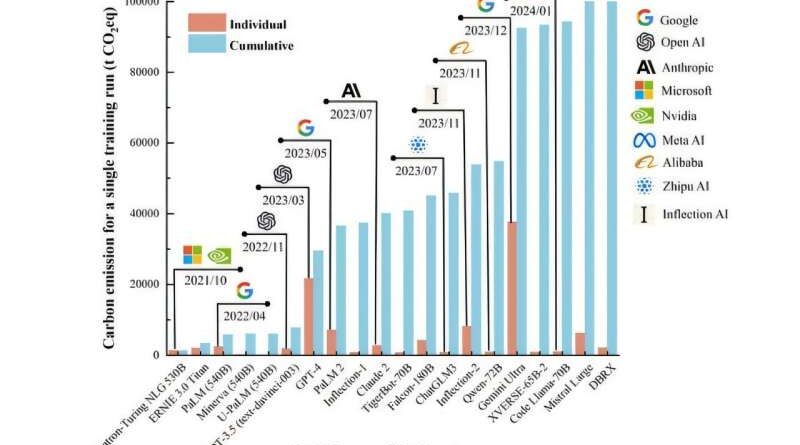Artificial Intelligence: A Double-Edged Sword for the Environment?

Top 20 AI systems on carbon emissions for one training session. Credit: Frontiers in Environmental Science and Engineering (2024). DOI: 10.1007/s11783-024-1918-y
As AI technology has advanced, the energy requirements for training many types of AI have increased, giving rise to widespread concerns about the associated carbon emissions. This rapid growth is fueled by global demand across industries and academia, leading to massive increases in computing power with significant environmental impacts.
Because of these challenges, in-depth research is essential to fully understand the carbon footprint of AI and to develop strategies to reduce its impact on the environment.
In a study published in Frontiers in Environmental Science and Engineering On October 20, 2024, researchers from Zhejiang University and Nankai University analyzed the emissions from 79 large AI systems between 2020 and 2024, highlighting the need for regulatory measures and common emissions gaps .
Studies estimate that these AI systems could emit more than 102 million tons of CO2 year on year, indicating an urgent need for strategies to reduce the environmental impact of AI.
The research team measured carbon emissions from popular AI models released between 2020 and 2024, finding significant differences in energy consumption. For example, Google’s Gemini Ultra model alone accounts for 36.7% of emissions among top AI systems, while GPT-4’s emissions rose twelve times compared to before it.
The study reveals that the operational demands of AI applications often eclipse the spirit of training, and the annual costs are estimated to be 960 times from one training due to global demand. of AI services.
Economically, the implications are many. With an estimated carbon price of $109 a ton, AI-related emissions could cost the industry more than $10 billion a year. These findings highlight the need for standardized metrics and caps, as AI carbon is now compared to emissions from all countries.
Dr. Meng Zhang, a leading researcher at Zhejiang University, said, “The clear growth of AI capabilities shows the rise of its environmental impact.
“Our goal is to equip policymakers with the information needed to address AI carbon through effective policies,” said Dr. Zhang, emphasizing that balancing AI productivity with environmental responsibility is key to fostering a sustainable future.
The results of the study have significant implications for environmental policy and AI development. As AI applications grow worldwide, controlling carbon emissions becomes critical to reducing environmental impacts and meeting climate goals.
Emission caps can encourage industry to use more efficient energy systems, which in turn spurs innovation in sustainable AI technology. In addition, carbon metrics related to AI can help policymakers set practical standards, ensuring that as AI progresses, its environmental costs are controlled, paving the way for a sustainable future. of AI.
Additional information:
Yang Yu et al, Revisiting the environmental impact of artificial intelligence: an overlooked carbon source?, Frontiers in Environmental Science and Engineering (2024). DOI: 10.1007/s11783-024-1918-y
Issued by the Chinese Academy of Sciences
Excerpt: Artificial Intelligence: A double-edged sword for the environment? (2024, November 4) retrieved November 4, 2024 from https://phys.org/news/2024-11-artificial-intelligence-edged-sword-environment.html
This document is subject to copyright. Except for any legitimate activity for the purpose of private study or research, no part may be reproduced without written permission. Content is provided for informational purposes only.
#Artificial #Intelligence #DoubleEdged #Sword #Environment
